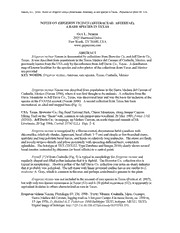
Notes on Erigeron vicinus (Asteraceae: Astereae), a rare species in Texas PDF
Preview Notes on Erigeron vicinus (Asteraceae: Astereae), a rare species in Texas
?(Asteraceae: Astereae), a rare species in Texas. Phytoneuron 2010-36: NOTES ON ERIGERON VICINUS (ASTERACEAE: ASTEREAE), A RARE TEXAS SPECIES IN Guy Nesom L. 2925 Hartwood Drive TX USA Fort Worth, 76109, www.guynesom.com ABSTRACT Erigeron vicinus Nesom documented by collections from Brewster Co. and Jeff Davis Co., is Texas. It was described from populations in the Sierra Madera del Carmen of Coahuila, Mexico, and USA A previously known from the only by the collection from Jeff Davis Co., Texas. distribution map of known localities for the species and color photos of the collections from Texas and Mexico are provided KEY WORDS: Erigeron vicinus, Astereae, rare species, Texas, Coahuila, Mexico Erigeron vicinus Nesom was described from populations in the Sierra Madera del Carmen of A Coahuila, Mexico (Nesom 1990), where was first thought to be endemic. collection from the it Davis Mountains in Jeff Davis Co., Texas, was discovered later and was the basis for inclusion of the FNANM A species in the account (Nesom 2006). second collection from Texas has been encountered, as cited and mapped here (Fig. 1). USA. Texas. Brewster Co. Big Bend National Park, Chisos Mountains, along Juniper Canyon : Hiking Trail on the "Basin" side, common in oak-juniper-pine woodland. 20 May 1985, Porter 1 166 (SJNM). JeffDavis Co.: in seepage, up Madera Canyon, on north slope and summit of Mt. Livermore, 20 Sep 1966, Correll 33741 (LL). Figs. 2-4. Erigeron vicinus recognized by a fibrous-rooted, rhizomatous habit (caudices with is rhizomelike, relatively slender, lignescent, basal offsets 1-7 cm) and simple or few-branched stems, spatulate and long petiolate basal leaves, and heads on relatively long peduncles. The stems are finely and loosely strigose distally and pilose proximally with spreading-deflexed hairs, completely TEX eglandular. The holotype at (TEX-LL Type Database and Images 2010) clearly shows several basal rosettes connected by rhizomes (or basal offsets) to a central point. Eryxell 2 724 from Coahuila (Fig. 5) is typical in morphology for Erigeron vicinus and regularly shaped and filled pollen indicates that it is diploid. The Brewster Co. collection also is typical in morphology. Abortive pollen of the JeffDavis Co. collection (see notes on sheet) indicates E that it probably was polyploid. The tall stems with linear proximal cauline leaves are similar to modestus A. Gray, which common in the area and perhaps contributed a genome to the plant. is Erigeron vicinus was not included in the account of rare species in Texas (Poole et al. 2007), but with only two known occurrences in Texas (S and 6-20 global occurences (G2), apparently 1) it is equivalent in status to others characterized as rare in Texas. Erigeron vicinus Nesom, Phytologia 69: 256. 1990. TYPE: Mexico. Coahuila. Mpio. Ocampo, Sierra Madera del Carmen, logging road ca 1 km past Campo 4 in mesic forest, ca. 2500 m, & MEXU, 5 Apr 1976. D. Riskind T. Patterson 1988 (holotype: TEX!; isotypes: TEX!). 1 Digital image of holotype: http://129.116.69.198:427/pics/ready/00373583. JPG. Perennials, 10-30 cm; rhizomatous, fibrous-rooted, caudices with rhizomelike, relatively slender, lignescent, basal offsets 1-7 cm. Steams ascending, branched at or below midstems, pilose on proximal 1/3, hairs spreading-deflexed, loosely strigose distally, eglandular. Leaves basal, usually persistent, and cauline; basal blades lanceolate to oblanceolate or narrowly obovate, 10-30 x 3-10 mm, cauline little reduced distally, margins entire or with 1-2 pairs of teeth, loosely strigose with ascending hairs, eglandular. Heads i(-2) on branches from or proximal to midstem. Involucres 4-5 x 7-10 mm. Phyilaries in 2-3 series, sparsely hirsute, sparsely minutely glandular. Ray florets 60- 7-10 mm, 95, corollas white, with lilac abaxial midstripe, laminae not coiling or reflexing. Disc mm, mm, corollas 1.8-2.2 throats slightly indurate or inflated. Cypselae 0.6-0.8 2-nerved, faces sparsely strigose. Pappus: outer of scales, inner of 8-1 1 bristles. ACKNOWLEDGEMENTS I'm grateful to Ken Heil at SJNM (Farmington, New Mexico) for his hospitality while Tom TEX studying in the herbarium there and to Wendt for providing photos of specimens. LITERATURE CITED Nesom, G.L. 1990. Two new species of Erigeron (Asteraceae: Astereae) from Mexico. Phytologia 254-257. 69: Nesom, G.L. 2006. Erigeron (Astereae). Pp. 256-348 in Flora of North America Editorial Committee (eds.) Flora of North America North of Mexico, Vol. 20. Oxford Univ. Press, New York and Oxford. A&M Poole, J.M., W.R. Carr, D.M. Price, and R. Singhurst. 2007. Rare Plants of Texas. Texas J. Univ. Press, College Station. TEX-LL Type Database and Images. 2010. University of Texas Herbaria (TEX-LL). Plant Resources Center, Univ. of Texas, Austin, <http://www.biosci.utexas.edii/rjrc/types.htnil> Figure Distribution ofErigeron 1 . Figure 2. Erigeron \ 5 from Brewster County, Texas (Porter ii65). Figure 3. Close-up of plants from Porter 1166. Erigeron vicinus in Texas 5 : Figure 4. Erigeron vicinus from Jeff Davis County, Texas (Correll 33741). Erigeron vicinus in Texas 6 : ® Figure 5, Erigeron vicinus from the Sierra Madera del Carmen in Coahuila, Mexico (Fryxell 2724).
